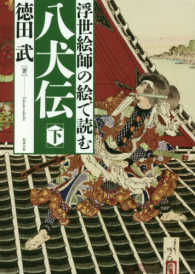Full Description
This book documents the journalistic career of Mohandas K. Gandhi. Known as the Mahatma and the Father of India, Gandhi was also a journalist. However, he was a not a journalist in the same vein as those working for the New York Times or the BBC. Rather, Gandhi was what is called an advocacy journalist; that is, his journalism served various political, social, and cultural causes—most importantly, in the long run, the Indian independence movement. Among the other key causes were equality, human rights, Muslim-Hindu relations, vegetarianism, chastity, poverty, and hygiene. The chapters in this book were written by authors who attended a conference on Gandhi and media at the University of St. Andrews on the 150th anniversary of Gandhi's birthday, in October 2019. It relies on careful analysis of his newspapers, produced in both South Africa and India, including Indian Opinion, Young India, the Gujarati newspaper Navajivan, and three versions of Harijan, which were in English, Gujarati, and Hindi. The authors also place Gandhi's version of journalism in a historical context of small, family-operated weekly newspapers that were commonplace in the nineteenth century. Finally, the book looks at other media tools Gandhi used to transmit his messages to the public, including his recorded voice for gramophone.
Contents
Foreword by Rajmohan Gandhi - David W. Bulla: Introduction - David W. Bulla: Origins of Gandhi's Advocacy Journalism - Parmeet Kajal: Gandhi Versus Gandhi: A Comparative Study of His English and Vernacular Newspapers - Anjana Sharma: Closing the Circle: Gandhi in Bihar, 1947 - David W. Bulla: Gandhi, Swaraj, and Press Freedom - Sanjiv Kakar: A Sanitarian in a World of Modern Medicine: Gandhi's Health Bulletins in Indian Opinion, 1903-1914 - Farwa Imam Ali: Mahatma, Bapu, Naked Fakir: Gandhi through the Lens of the Muslim Press before and after Independence, 1920-1960 - Norma Fay Green: Satyagraha Journalism—New York Style: Gandhi's Influence on Dorothy Day and The Catholic Worker - Satrajit Ghosh Chowdhury: Gandhi and "The Jews": An Article that Changed the Mahatma's Image for the Jews - Gopa Sabharwal: Gandhi's Prayer Meetings and Partition - Dipannita Dutta: Gandhi, Gramophone, and God: Story of an Uncomfortable Union - James Buie: Gandhi's Mediated Image: Portrayed as Saint, Bigot, Pervert, a Flawed Human, Victim of British Conspiracy, and Ultimately a Man of His Own Time - Christel R. Devadawson: Visual Advocacy, the Gandhi Icon, and the Shaping of Contemporary India - Bibliography - Contributors - Index.








